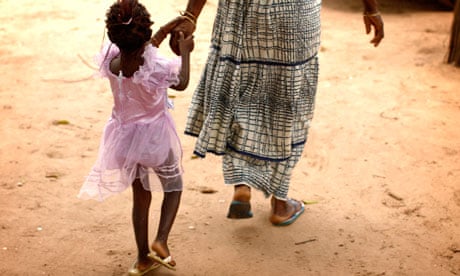Almost one in five young girls in sub-Saharan Africa are still forced to endure female genital mutilation (FGM), according to a UN report that paints a grim picture of the state of the world's children.
Statistics released by Unicef, the UN agency for children, in Every child counts: revealing disparities, advancing children's rights, published on Thursday, shows problems such as violence, child marriage and FGM are widespread across some of the world's poorest countries. The release of the figures comes ahead of the 25th anniversary of the convention on the rights of the child in November.
Unicef refers to figures published last year in its first report summarising and analysing data from the 29 countries in Africa where FGM is the most prevalent. Eighteen of these countries are in west and central Africa. In 2012, the UN general assembly passed a resolution demanding greater efforts to eliminate the practice. The resolution specifically called for data to be collected using common methods and standards.
FGM, recognised internationally as a violation of the human rights of girls and women, can cause severe bleeding and problems urinating. It can also lead to cysts, infections, infertility and complications in childbirth. About 140 million girls and women worldwide are living with the consequences of FGM, which is mostly carried out on young girls between infancy and age 15.
The Unicef report highlights the importance of data in making progress for children and exposing the unequal access to services and protections.
"Data has made it possible to save and improve the lives of millions of children, especially the most deprived," said Tessa Wardlaw, head of Unicef's data and analytics section. "Further progress can only be made if we know which children are the most neglected, where girls and boys are out of school, where disease is rampant, or where basic sanitation is lacking."
The figures show that almost four-fifths of the world's children are subject to violent discipline – defined as physical punishment or psychological aggression – at home or in school. In the Democratic Republic of the Congo, which has been plagued by conflict for decades, 92% of children face physical violence at school or at home.
"In countries of conflict, children are in danger of seeing violence as a part of everyday life – often witnessing horrific scenes of fighting and then experiencing further violent acts at home or school," says Unicef. "Children who experience violence can often go on to commit it themselves, which makes breaking the cycle essential."
Rates of child marriage are high, with around one in 10 girls in the world being married before the age of 15 – jeopardising their rights to health, education and protection. Girls in Central African Republic are now almost twice as likely to be forced into marriage by the age of 15 compared with girls in Afghanistan (29% and 15% respectively). More than a third of girls in Niger are married before they reach the age of 15.
Figures reveal large disparities between rich and poor families, particularly in deaths of under-fives. High-income countries accounted for 11% of the world under-five population in 2012, but only 1.4% of global under-five deaths. Low-income countries accounted for around 20% of the world's under-five population, but had one-third of under-five deaths.
Of the roughly 18,000 children under five who die every day – 6.6 million children under five died in 2012 – a disproportionate number are from areas of cites or the countryside that are cut off from services because of poverty or geography. Although diarrhoea can be treated effectively and cheaply with oral rehydration salts, children with diarrhoea from the richest homes are up to four times more likely to be treated than those from the poorest homes.
Some 15% of the world's children are involved in child labour, infringing on their right to learn and play.
But Unicef's data also shows gains made in the last decade: about 90 million more children would have died had mortality rates stayed at their 1990 level (before the 2000 millennium development goals were introduced); and deaths from measles among under-fives fell from 482,000 in 2000 to 86,000, thanks in large part to increased immunisation.

Comments (…)
Sign in or create your Guardian account to join the discussion